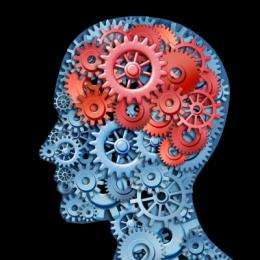Brain clues reveal risk of psychotic illness

(Medical Xpress)—New research has shown that people with psychotic illness show similar brain changes to immediate family members who present no signs of illness.
In a study detailed in the journal JAMA Psychiatry, researchers at Monash University, in collaboration with The University of Melbourne and the University of Cambridge, UK, found that these brain changes represent a marker of genetic risk of developing psychotic illnesses, such as schizophrenia.
Lead researcher, Associate Professor Alex Fornito, Deputy Director of Monash Clinical and Imaging Neuroscience in the School of Psychology and Psychiatry, said these genetic markers could be targeted in the development of new treatments that may help to reduce the risk of developing psychotic illness.
"First-degree relatives of people with psychosis are at increased genetic risk of developing a psychotic illness," Associate Professor Fornito said.
"We have found that people with psychosis and their unaffected first-degree relatives, who otherwise present no signs of illness, show similar brain changes when compared to healthy people."
Associate Professor Fornito said even at the earliest signs of illness, patients showed altered activity (when compared to healthy people) in a specific brain circuit that links a region deep in the brain called the striatum with the prefrontal cortex. This circuit plays an important role in attention, learning and memory.
"The fact that we see the same brain changes in this group, in the absence of any overt signs of illness, points to a neural biomarker of risk for psychosis," Associate Professor Fornito said.
"Patients who showed more severe changes in this circuit also showed more severe psychotic symptoms, providing a direct link between these brain changes and illness severity."
The study examined 19 young people experiencing their first episode of psychotic illness and 25 of their unaffected parents or siblings. A group of 26 healthy unrelated participants was also recruited to draw comparison.
The researchers used magnetic resonance imaging, or MRI, to map the activity of different brain systems.
The study also found a change in brain activity that was specific to patients but not their relatives. Associate Professor Fornito said this change may reflect a 'switch' that determines whether a person transitions from an at-risk state to full-blown illness.
"We know that activity in brain circuits linking the striatum and prefrontal cortex are heavily influenced by the neurotransmitter dopamine, which is a major target for all medications currently used to treat psychosis," Associate Professor Fornito said.
"The difficulty is that these drugs have rather diffuse effects on the brain, affecting many different systems. They also often have unpleasant side effects.
"Our findings point to a more specific treatment target. We are currently investigating whether we can selectively improve activity patterns in the affected brain circuits using non-invasive magnetic stimulation techniques. If successful, using these techniques in at-risk populations may help delay, minimise or prevent the impact of psychosis onset."
Approximately three in 100 people will experience a psychotic episode at some point in their life. Psychotic disorders have been estimated to cost the Australian economy over $2 billion each year.













